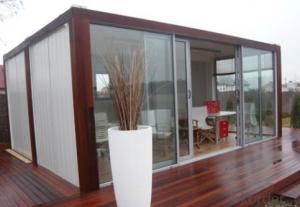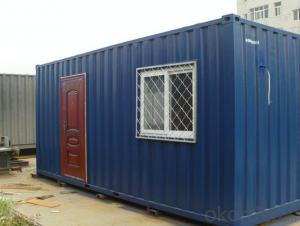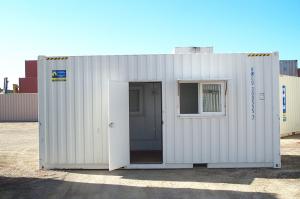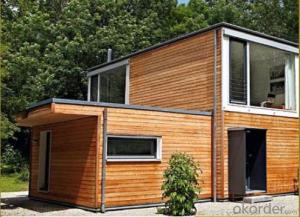Prefabricated shipping containers shops, cafes
OKorder Service Pledge
OKorder Financial Service
You Might Also Like
Specifications
1low cost modular house. low cost
2. easy installation
3 Green and environmental material
4. Power-Saved
Specifications
1. Firm structure and multiple use.
2. Lost cost and convenient in shippment.
CNBM INTERNATIONAL LOW COST PREBUILT CONTAINER HOUSES
Product description
1. Container house is a unit house with the size of 6055mm*2435mm*2740mm.
2. The container house adopts EPS, glass wool or rock wool as heat insulation material.
3. All the components are standard and prefabricated with the advantage of assembling and disassembling easily. Six skilled workers can finish three modular units in 8 hours.
4. 4sets of standard container house can be packed together to replace the shipping space of one 20ft container.
5. The container house can be linked freely at length, width and height through the linking kits for bigger structure and different layout.
6. Waterproof design of galvanized structure, fireproof and heat insulation of material ensure the house to resist heavy wind load of 0.6KN/m2and 8 degree seismic intensity.
7. The life span of the house is 20-25 years.
Characteristics
1. Cost Effectiveness
2. Chemical free, and lower waste
3. Easy to erect
4. Safety
5. Fireproof, termite free
6. Strong and durable – weatherproof, anti-seismic
7. Materials will not shrink, rot or warp
8. Pre-galvanized for rot and corrosion prevention
Benefits of factory built prefabricated houses and villas
| |
Very little maintenance | Reduce environmental pollution and save water |
Ease and speed of erection | Easily transportable |
Aesthetically pleasing | Buildings can be relocated |
Priced more economically than brick | Buildings can be designed by your choice
|
- Q:Do container houses require special permits?
- Yes, container houses generally require special permits to be constructed and occupied. The requirements for permits may vary based on location and local building codes, but it is important to check with the relevant authorities to ensure compliance with regulations and obtain necessary permits before building or moving into a container house.
- Q:Are container houses prone to rusting?
- Steel is typically used to build container houses, but it is prone to rusting. However, by properly maintaining and treating container houses, rusting can be prevented. Most container houses go through corten steel treatment, which applies a protective layer to avoid rust formation. Regular inspections and maintenance are also important to detect and address any potential rusting problems. It's worth mentioning that the durability and lifespan of a container house depend on factors such as the quality of the steel, climate conditions, and maintenance efforts. In summary, while container houses are susceptible to rusting, they can remain durable and structurally sound with proper care and maintenance.
- Q:Are container houses cost-effective?
- Yes, container houses can be cost-effective for several reasons. Firstly, the materials used to build container houses are often cheaper compared to traditional construction materials such as bricks and cement. This can result in significant cost savings during the construction process. Additionally, container houses can be built relatively quickly, which further reduces labor costs. Furthermore, container houses are known for their energy efficiency. The compact design and the use of insulated materials make them easier to heat or cool, resulting in lower energy bills. Additionally, container houses can be equipped with solar panels or other renewable energy sources, further reducing energy costs. Moreover, container houses are highly durable and require minimal maintenance. The steel structure of shipping containers makes them resistant to harsh weather conditions and natural disasters, reducing the need for costly repairs or replacements in the long run. Finally, container houses offer great versatility. They can be easily modified or expanded, allowing homeowners to customize and adapt their living space as their needs change over time. This flexibility can save money compared to buying or building a new house to accommodate changing circumstances. Overall, while the cost-effectiveness of container houses depends on various factors such as location and customization, they generally offer lower construction and maintenance costs, energy efficiency, and flexibility, making them a cost-effective housing option for many individuals and families.
- Q:Can container houses be insulated for extreme climates?
- Indeed, container houses have the capability to be insulated for extreme climates. The use of shipping containers as a building material offers inherent strength and durability, enabling them to withstand severe weather conditions. To insulate a container house for extreme climates, multiple methods can be utilized. One frequently employed technique involves applying insulation material to the interior walls of the container. This can be achieved by utilizing rigid foam insulation boards or spray foam insulation. These materials possess exceptional thermal resistance, effectively maintaining a stable interior temperature, even in extremely hot or cold climates. To further enhance insulation, it is advisable to install double-glazed windows and insulated doors. By doing so, heat loss or gain through these areas can be prevented, ensuring a comfortable interior regardless of external temperatures. Moreover, it is crucial to properly seal any gaps or openings in the container to prevent air leakage, which can compromise the insulation. This can be accomplished by using weatherstripping or caulking to seal gaps around windows, doors, and any other potential entry points for air. Additionally, incorporating passive design strategies can contribute to improved insulation in container houses. This includes orienting the house to maximize natural sunlight, utilizing shading devices to minimize heat gain in hot climates, and implementing ventilation strategies to promote air circulation and reduce reliance on mechanical cooling or heating. In conclusion, container houses can certainly be insulated for extreme climates. Through the utilization of various insulation techniques, sealing gaps, and incorporating passive design strategies, container houses can be made comfortable and energy-efficient, even in the most challenging weather conditions.
- Q:Are container houses safe during natural disasters?
- Container houses can be made safe during natural disasters with proper design and construction. Reinforcements such as additional support beams and strong foundations can enhance their structural integrity. Additionally, implementing measures like insulation, storm shutters, and secure tie-downs can further protect container houses from the impact of natural disasters. However, it is important to note that each case should be evaluated individually, considering the specific needs and requirements of the location and type of natural disaster.
- Q:Are container houses suitable for art galleries?
- Art galleries can indeed find container houses to be a suitable option. The rising popularity of using shipping containers in architecture is due to their affordability and versatility. In the context of art galleries, container houses bring several advantages. First and foremost, the modular nature of shipping containers allows for easy customization and expansion. Artists and curators can stack, combine, or arrange containers in various configurations to create unique gallery layouts. This flexibility enables them to adapt the space according to their specific needs and artistic visions. Secondly, container houses are renowned for their durability. Designed to withstand harsh marine environments, shipping containers are structurally robust and weather-resistant. This characteristic ensures the protection of valuable artworks from potential damage caused by external elements like moisture, pests, or extreme temperatures. Furthermore, container houses offer an industrial and contemporary aesthetic that can complement and enhance the artwork displayed within. The raw, minimalistic design of containers creates a unique backdrop for various art styles, ranging from contemporary to avant-garde. Additionally, container houses are often more cost-effective compared to traditional building methods. The price per square foot for container construction is generally lower, allowing art galleries to allocate more resources towards promoting and acquiring artwork. However, certain considerations must be taken into account when using container houses as art galleries. Insulation and climate control are crucial factors in preserving delicate artworks. To ensure a stable environment, proper insulation and HVAC systems should be installed to control temperature and humidity within the gallery space. Additionally, adequate lighting and security measures should be implemented to effectively showcase the artwork and protect it from theft or damage. In conclusion, container houses present a suitable option for art galleries, offering versatility, durability, affordability, and a unique aesthetic. However, addressing insulation, climate control, lighting, and security is essential in creating an optimal environment for showcasing and preserving artworks.
- Q:Are container houses safe to live in?
- When container houses are designed, constructed, and maintained properly, they are indeed safe to live in. These houses are made from steel shipping containers, which are highly durable and designed to withstand even the harshest transportation conditions. They have been extensively tested and proven to be structurally sound, capable of withstanding hurricanes, earthquakes, and heavy snow loads. To ensure the safety of residents, container houses undergo various modifications to meet building and safety regulations. These modifications involve reinforcing the structure with additional steel beams, installing proper insulation and ventilation systems, and incorporating windows and doors that meet safety standards. Furthermore, container houses can be equipped with all the necessary amenities to provide a comfortable and secure living environment. They can be designed to include plumbing and electrical systems, heating and cooling units, and even fire suppression systems. Proper insulation can also be added to maintain comfortable indoor temperatures and improve energy efficiency. It is crucial to note that, similar to any other form of housing, the safety of a container house largely depends on the quality of construction and adherence to building codes. Therefore, it is essential to collaborate with reputable and experienced professionals during the design and construction process to ensure that all safety requirements are met. In conclusion, when designed and constructed properly, container houses can serve as safe and practical housing options. They offer durability, resistance to extreme weather conditions, and the ability to provide all necessary amenities for a comfortable and secure living environment.
- Q:Are container houses suitable for individuals who enjoy DIY projects?
- Yes, container houses are definitely suitable for individuals who enjoy DIY projects. In fact, they can be an excellent choice for those who love to get their hands dirty and take on various DIY tasks. Container houses provide a great opportunity for creative individuals to design and build their own unique living space. One of the key advantages of container houses is their modular design, which allows for easy customization. Individuals can easily modify the interior and exterior of the container to suit their preferences. DIY enthusiasts can utilize their skills to create personalized layouts, install unique fixtures, and add creative touches to their container homes. Moreover, container houses offer a cost-effective option for DIY projects. Containers can often be purchased at a relatively low price, especially when compared to traditional construction materials. This allows individuals to allocate more of their budget towards customizing and upgrading their container home. Container houses also provide a great opportunity for individuals to practice sustainable living. By repurposing shipping containers, DIY enthusiasts can contribute to the reduction of waste and promote eco-friendly lifestyles. They can incorporate energy-efficient features such as solar panels, rainwater harvesting systems, and smart appliances to further enhance sustainability. Additionally, container houses are relatively easy to construct compared to traditional houses. With some basic construction knowledge and skills, individuals can take on the challenge of building their own container home. There are numerous resources available online, including step-by-step guides and video tutorials, that can assist DIY enthusiasts throughout the construction process. In conclusion, container houses are an excellent choice for individuals who enjoy DIY projects. They offer a customizable and cost-effective solution for those who want to design and build their own living space. With their modular design, sustainability options, and relative ease of construction, container houses provide a perfect platform for DIY enthusiasts to showcase their creativity and skills.
- Q:Are container houses suitable for areas with limited access to emergency services?
- Areas with limited access to emergency services may find container houses to be a suitable option, but it is important to consider several factors. Firstly, container houses are designed to be durable and sturdy, as they are made of steel and can withstand extreme weather conditions. They are also resistant to fire, pests, and mold, which adds a level of safety and security in areas where emergency services may be delayed. Moreover, container houses can be customized and equipped with safety features to enhance their suitability for areas with limited emergency services. For instance, installing fire alarms, smoke detectors, and fire extinguishers can reduce the risk of fire. Similarly, incorporating security systems and secure doors can deter potential intruders and provide peace of mind. However, it is crucial to remember that container houses should not be considered a complete replacement for emergency services. While they can offer some level of protection, they cannot replace the immediate assistance provided by trained professionals during emergencies. Hence, individuals residing in areas with limited access to emergency services should have alternative plans in place. This may involve having a well-stocked first aid kit, acquiring basic first aid and emergency response skills, and establishing communication channels with neighbors or nearby communities. In conclusion, container houses can serve as a viable housing solution in areas with limited access to emergency services, but it is crucial to acknowledge their limitations and take proactive measures to ensure personal safety and well-being.
- Q:Are container houses resistant to floods?
- The resistance of container houses to floods can vary depending on their construction and location. Measures can be taken to enhance their structural integrity and flood resistance. Elevating the containers on stilts or pillars can prevent them from being submerged in floodwaters. Additionally, applying proper insulation, waterproofing, and sealants can prevent water from infiltrating the house during a flood. It is also essential to securely anchor the container house to its foundation to withstand the force of floodwaters. However, it is important to acknowledge that no building is entirely flood-proof, and the severity and duration of a flood can impact the resilience of any structure, including container houses. Therefore, consulting experts and complying with local building codes and regulations is recommended to maximize the flood resistance of container houses in flood-prone areas.
1. Manufacturer Overview |
|
|---|---|
| Location | |
| Year Established | |
| Annual Output Value | |
| Main Markets | |
| Company Certifications | |
2. Manufacturer Certificates |
|
|---|---|
| a) Certification Name | |
| Range | |
| Reference | |
| Validity Period | |
3. Manufacturer Capability |
|
|---|---|
| a)Trade Capacity | |
| Nearest Port | |
| Export Percentage | |
| No.of Employees in Trade Department | |
| Language Spoken: | |
| b)Factory Information | |
| Factory Size: | |
| No. of Production Lines | |
| Contract Manufacturing | |
| Product Price Range | |
Send your message to us
Prefabricated shipping containers shops, cafes
OKorder Service Pledge
OKorder Financial Service
Similar products
New products
Hot products
Hot Searches
Related keywords

























